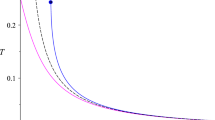Abstract
We show within the usual two-dimensional approximation that unitarity and the restoration of Minkowski vacuum correlations at the end of black hole evaporation impose unexpected constraints on its mass loss rate: before disappearing the black hole emits one or more negative energy burst, leading to a temporary increase of its mass.

Similar content being viewed by others
Notes
It is immediate to estimate the size of the core of a black-hole-like object with the singularity resolved at a Planck-scale energy density: if we concentrate all the mass \(M\) of the black hole in a core of size \(\ell \) we find a density \(\varrho \sim M/\ell ^3\). A Planck scale upper bound \(\varrho \sim \hbar ^{-1}\) results in a core of size \(\ell \sim (M\,\hbar )^{1/3}\). For a solar mass black hole this size is \(10^{12}\) times larger that the Planck length \(\ell _P=\hbar ^{\,1/2}\) and can be described by a classical effective metric.
We partially fix the ambiguity in the choice of the affine parameter \(u\) by demanding that the future-pointing null vectors \(l=\partial _v\) and \(n=\partial _u\) have scalar product \(l\cdot n=-1\) at spatial infinity.
In terms of the ray-tracing function this condition corresponds to \(\dot{p}(u)\rightarrow 1\) smoothly as \(u\rightarrow \pm \infty \), i.e. no redshift or blueshift at initial and late times.
References
Hawking, S.W.: Particle Creation by Black Holes. Commun. Math. Phys. 43, 199–220 (1975)
Hawking, S.W.: Black hole explosions. Nature 248, 30–31 (1974)
Hawking, S.W.: Breakdown of Predictability in Gravitational Collapse. Phys. Rev. D14, 2460–2473 (1976)
Ashtekar, A., Bojowald, M.: Black hole evaporation: A Paradigm. Class. Quant. Grav. 22, 3349 (2005)
Hayward, S.: Formation and Evaporation of Nonsingular Black Holes. Phys. Rev. Lett. 96, 031103 (2006)
Rovelli, C., Vidotto,F.: “Planck stars”, arXiv (2014) http://arXiv.org/abs/1401.6562v4
Frolov, V.P.: “Information loss problem and a ’black hole‘ model with a closed apparent horizon”, JHEP 1405 (2014) 049, http://arXiv.org/abs/1402.5446v2
Barcelo, C., Liberati, S., Sonego, S., Visser, M.: Minimal conditions for the existence of a Hawking-like flux. Phys. Rev. D 83, 041501 (2011)
Birrell, N.D., Davies, P.C.W.: Quantum Fields in Curved Space. Cambridge University Press, (1982)
Walker, W.R.: Particle and Energy Creation by Moving Mirrors. Phys. Rev. D 31, 767 (1985)
Ashtekar, A., Taveras, V., Varadarajan, M.: Information is Not Lost in the Evaporation of 2-dimensional Black Holes. Phys. Rev. Lett. 100, 211302 (2008)
Bombelli, L., Koul, R.K., Lee, J., Sorkin, R.D.: A Quantum Source of Entropy for Black Holes. Phys. Rev. D34, 373–383 (1986)
Holzhey, C., Larsen, F., Wilczek, F.: Geometric and renormalized entropy in conformal field theory. Nucl. Phys. B 424(3), 443–467 (1994)
Bianchi, E., Smerlak, M.: Entanglement entropy and negative energy in two dimensions. Phys. Rev. D 90(4), 041904 (2014)
Bianchi, E., Smerlak, M.: “Entanglement entropy production in gravitational collapse: covariant regularization and solvable examples”, in preparation.
Page, D.: Information in black hole radiation. Phys. Rev. Lett. 71, 3743–3746 (1993)
Acknowledgments
We thank Abhay Ashtekar and Ted Jacobson for useful discussions on energy and unitarity in black hole evaporation.
Author information
Authors and Affiliations
Corresponding author
Rights and permissions
About this article
Cite this article
Bianchi, E., Smerlak, M. Last gasp of a black hole: unitary evaporation implies non-monotonic mass loss. Gen Relativ Gravit 46, 1809 (2014). https://doi.org/10.1007/s10714-014-1809-9
Received:
Accepted:
Published:
DOI: https://doi.org/10.1007/s10714-014-1809-9




